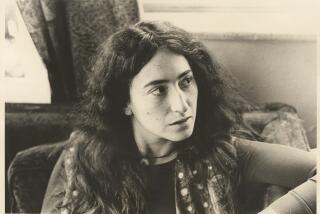A Present of All Things Past
- Share via
Alan Sheridan acknowledges his sustained sequential narrative of Andre Gide’s life, undertaken almost 50 years after Gide’s death, to be a “hybrid form,” a literary biography without the compurgations of theory; yet so scrupulous is his engagement in the inextricably fertile clutter of a very long career and a very labile oeuvre that “A Life in the Present” proves to be the best book on Gide I know (I have read the principal French, British, American and German ventures; have translated four of Gide’s books and have presumed to write on Gide myself: so much for hostages). Certainly Sheridan’s is the first book anyone interested in this author should consult after reading Gide’s own work and--in the case of certain precariously “sincere” Gidean texts, such as “Corydon”--even before.
I somewhat muddy the waters of estimation with this matter of theory because of Sheridan’s previous performances: a translator of (among others) Jacques Lacan and Michel Foucault, he is also the author, quite recently, of a severe analysis of Foucault much concerned with what is called “grand theory.” He has now changed his mind (in the sharpest sense of that phrase), and perhaps the most important aspect of this new study of a much-traced figure is the author’s statement of what it is not: “I have no theory about Gide. I have lost whatever faith I ever had in man’s attempt to understand himself in general terms. . . . I have wasted too many long hours wrestling with such problems, hours better spent in the company of particular human creations. For me such grand theories have turned out to be fictions, less instructive and less entertaining than fictions that only pretend to tell the truth. . . . I would hope the reader of this book would acquire, bit by bit, an evermore complex view of Gide, just as one gets to know, and not to know, a friend.”
With great diligence, then, and with a sympathetic perception of his subject’s central determination to see himself as being forever dual “and therefore not to be confined within any one thing,” Sheridan pursues Gide through that remarkable pattern of “returns” that characterize his labyrinthine life and that can be identified by his remarkably discrepant works: return from Puritanism (“Fruits of the Earth”) and from Narcissism (“Andre Walter” and the five early “treatises”), return from Symbolism (“Marshlands”) and from Christianity (“Strait Is the Gate”), return from absurdist comedy (“Prometheus Ill-Bound,” and “Lafcadio’s Adventures”) and from literary responsibility (founding and directing the Nouvelle Revue Francaise), return from marriage (“The Immoralist,” “School for Wives”) and from homosexuality (“Corydon” and fathering a daughter); return from communism (“Return from the USSR”) and even from controversiality, or at least from controversy (“Theseus,” translations of Shakespeare, Whitman, Conrad and Blake). I would emphasize by the word “return” that Gide does not retreat from passions and positions espoused, however experimentally, in the fluctuations of a notoriously self-conscious life and literary production; rather, he returns to a core of ironic fervors (it is not irrelevant to invoke a Nietzschean intensity here) that afford him the possibility, ever and again, of escape from ideology, from fanaticism, from whatever Gide perceives as falsehood (“Saul,” “The Pastoral Symphony,” “Travels in the Congo” and the unremitting “Journals,” which inveterately serve as a corrective to any residual--and fallacious--commitment).
Along the way--”life too,” Sheridan asserts, “has its autonomy: It does not require justification by works”--we are given a generous narrative of the notorious intimacies and alienations (Valery, Claudel), displays of hopeless forbearance and happy infatuation (Madeleine Gide, Marc Allegret), instances of conscience and corruption (Mallarme, Wilde), of collaborative friendship and collegial betrayal (Martin du Gard, Cocteau), of excursions into a permissive exoticism and withdrawals to an equally permissive family seat (North Africa, Normandy) and on the level of literary technique, an inveterate vacillation between modish classicism and modernist contraption (“Oedipus,” “The Counterfeiters”).
As an inveterate dimension of that “Life in the Present,” one learns, there were the letters: To the solicitations of the world’s friendship and the world’s hostility, Gide corresponded. I wonder how he managed it, between his works and his journal, between a simmering professional life in Paris and a lacerating private one in Cuverville, between his elaborately staged travels and a vast program of reading fanatically pursued over seven decades and faithfully glossed in the journal--how did he find or make time for thousands and thousands of letters--letters written and, perhaps just as overwhelming, letters read: “over 30 complete correspondences published so far, some in two volumes,” as Sheridan wistfully remarks. Yet he has dutifully ransacked them all, and it is his consequent familiarity with the social and literary and political web within which this inky spider loomed that gives Sheridan the edge over so many other Gidean biographers, as evidenced by his boast that “few biographers of a major literary figure can have faced such scant competition.”
I believe as well that Sheridan’s is the first biography in English to include an adequate accounting of the Cahiers de La Petite Dame (this was Maria van Rysselberghe, widow of a Belgian painter, whose daughter was to become the mother of Gide’s only child, Catherine), four volumes covering the period from 1918 to Gide’s death in 1951. “Covering” is indeed the apposite word here, for the incessant, accurate and mercilessly affectionate reportage of this clear-eyed friend, amassed without the knowledge of her unwitting “victim” and published only after his death, would do more to eclipse and to disenchant Gide’s demonic self-image than all the attacks from Rome and Moscow, all the horrified attentions of an offended literary orthodoxy; henceforth no biographer can resist the Little Lady’s intimate revelations, but no heroic figure--especially the figure of an author committed to the unique presentation of an authentic, a “sincere” self--can withstand them.
So sensible and sympathetic, as well as powerful and politic, is Sheridan’s grand actuality (as opposed, he would have it, to some grand theory) of Gide’s life and work that I have but one caveat to enter in an entirely enthusiastic response. His book’s clever and provocative subtitle has a resonance that appears to distort a principal aspect of Gide’s achievement. The life Gide so intricately created “in the present” indeed does not alienate the oeuvre he just as intricately created from the past. It would be shortsighted to detach this most culminative of literary artists from all that preceded him in the world’s writing, which he sought to assimilate, to use and to reflect rather than to reject or to evade. Indeed, the inclusive nature of the life too--so effectively related in all its tentacular reaches by Alan Sheridan--is symbolically illustrated by a 1951 photograph of Gide, his daughter Catherine and her husband, Jean Lambert, their children and . . . Allegret, Gide’s lover of 1917, six years before Catherine was born. The family betrayed, the family shattered? No, the family reconstituted, by a perceptive tolerance, even a Goethean, or call it a Gideani reverence for all the dimensions of experience, including a life in the past.
More to Read
Sign up for our Book Club newsletter
Get the latest news, events and more from the Los Angeles Times Book Club, and help us get L.A. reading and talking.
You may occasionally receive promotional content from the Los Angeles Times.










